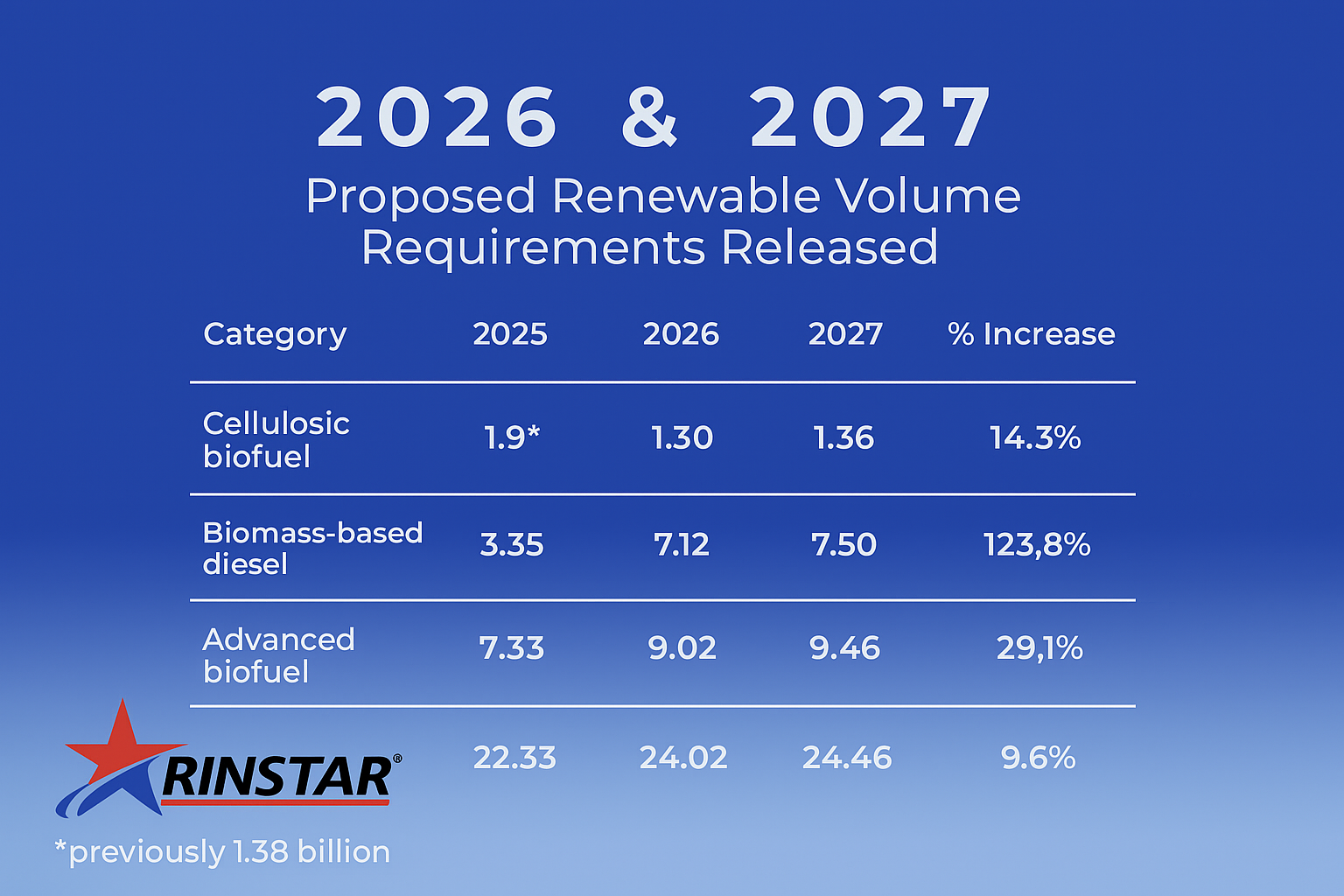In a long-anticipated move for the renewable fuels industry, the EPA released two major updates to the Renewable Fuel Standard (RFS) program on June 13, 2025. The first is a proposed rule outlining Renewable Volume Obligations (RVOs) for 2026 and 2027. The second is a finalized adjustment to the 2024 cellulosic biofuel target. These updates aim to strike a balance between supporting industry growth and ensuring regulatory practicality. As expected, the announcements have sparked a range of reactions from different interest groups.
Proposed RVOs for 2026 and 2027
Under the proposed rule released this month, the EPA aims to raise the national blending targets significantly. Total RVOs would increase to 24.02 billion gallons in 2026 and 24.46 billion gallons in 2027, up from the 22.33 billion gallons set for 2025.
Category-Specific Targets
The proposed volumes include:
- Cellulosic Biofuel: 1.30 billion RINs in 2026, rising to 1.36 billion RINs in 2027
- Biomass-Based Diesel: 7.12 billion RINs in 2026, increasing to 7.50 billion RINs in 2027
- Advanced Biofuel: 9.02 billion RINs in 2026, reaching 9.46 billion in 2027

Structural Program Changes
The proposal also introduces substantial modifications to RFS implementation, including:
- Reduced RIN values for imported fuels: Imported biomass-based diesel would receive lower per-gallon RIN credits (approximately 1.27–1.28 RINs per gallon, down from ~1.6).
- Partial waiver for 2025 cellulosic biofuel: Reflecting ongoing production shortfalls, the EPA is proposing to waive a portion of the previously set 2025 cellulosic mandate.
The EPA estimates that the updated targets could help reduce reliance on imported oil by as much as 150,000 barrels per day.
To gather input from stakeholders, the EPA will host virtual public hearings on July 8–9, providing an opportunity for individuals across the fuel supply chain to share feedback on the proposed 2026–2027 standards. Final rules are expected to be released later this year following the public comment period.
Anyone interested in attending the hearings—including those who do not plan to speak—must register by emailing RFS-Hearing@epa.gov. Please note that a separate registration must be submitted for each attendee, and the EPA has requested that all registrations be completed by July 1, 2025 .
The full legal text of the Proposed Rule can be found here
Removal of E-RINs
The EPA also revealed in their proposal that they are removing the proposed E-RIN program. This decision was largely based on public feedback highlighting challenges with verifying the use of renewable electricity and guaranteeing program integrity. While the EPA stated that it supports the long-term potential of an E-RIN framework, it concluded that additional time and collaboration with stakeholders was needed to build a system that is both effective and transparent. As a result, the final rule does not include E-RIN pathways or related registration requirements at this time.
2024 Cellulosic RVO Finalized
In a separate but related action, the EPA has finalized a reduction in the 2024 cellulosic biofuel Renewable Volume Obligation (RVO) to approximately 1.01 billion RINs reflecting current market conditions and the perceived limited availability of commercial-scale cellulosic fuels.
The final rule also provides clarification on RIN generation for biogas-derived fuels, particularly for the renewable natural gas (RNG) sector. Specifically, RNG RIN separators are now permitted to use documentation to verify the volume of compressed or liquefied natural gas (CNG/LNG) dispensed, rather than relying solely on specified GC, flow meters, or EPA-approved alternative measures.
The full legal text of the finalized rule can be found here.
With the 2026–2027 targets still under review and the 2024 adjustment now in place, obligated parties should prepare for an active second half of 2025 as policy and production continue to align.
At RINSTAR, we’ve been following the evolution of the Renewable Fuel Standard for more than 15 years. Our goal is to keep you informed on the latest policy changes and industry developments. Be sure to explore our other blog posts and subscribe to our newsletter to stay current in the world of renewable fuels.
